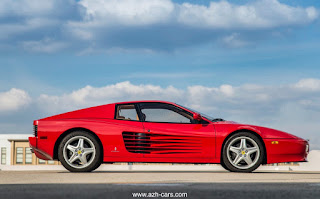The Ferrari Testarossa is a 12-cylinder mid-engine sports activities automobile synthetic through Ferrari, which went into manufacturing in 1984 because the successor to the Ferrari Berlinetta Boxer. The Pininfarina-designed automobile became initially constituted of 1984 to 1991, with version revisions following the finishing of Testarossa manufacturing and the creation of the Ferrari 512 TR and F512 M which have been constituted of 1992 to 1996.Almost 10,000 Testarossas, 512 TRs, and F512 Ms have been produced, making it one of the maximum not unusualplace Ferrari models, notwithstanding its excessive charge and exceptional layout. In 1995, the F512 M retailed for $220,000.
The Testarossa is a -door coupe with a hard and fast roof that premiered on the 1984 Paris Auto Show. All variations of the Testarossa had the electricity fed thru the wheels from a rear-hooked up, five-pace guide transmission. The Rear mid-engine, rear-wheel force layout (engine among the axles however in the back of the cabin) maintains the centre of gravity withinside the center of the automobile, which will increase balance and improves the automobile's cornering ability, and for this reason consequences in a status weight distribution of forty% the front: 60% rear.
The authentic Testarossa became re-engineered for 1992 and launched because the Ferrari 512 TR, on the Los Angeles Auto Show, correctly as a totally new automobile, and an stepped forward weight distribution of 41% the front: 59% rear. The F512 M became brought on the 1994 Paris Auto Show. The automobile dropped the TR initials and introduced the M which in Italian stood for modificata, or translated to modified, and became the very last model of the Testarossa, and persevered its predecessor's weight distribution development of 42% the front: 58% rear. The F512 M became Ferrari's remaining mid-engine 12-cylinder automobile, other than the F50 and Ferrari Enzo, presenting the company's remaining flat engine. The Testarossa became changed in 1996 through the the front-engined 550 Maranello coupe.
The Testarossa name, which means "purple head" in Italian, comes from the purple-painted cam covers at the flat-12 engine. The double entendre with a purple-headed lady became intentional - Ferrari and Pininfarina often use descriptive phrases associated with a female's frame while describing the fashion in their automobiles.
The Testarossa can hint its roots again to the faults of the 1981 512i BB. The troubles that the Testarossa became conceived to repair, protected a cabin that were given an increasing number of warm from the indoor plumbing that ran among the the front-hooked up radiator and the midships-hooked up engine and a loss of bags area. To repair those troubles Ferrari and Pininfarina designed the Testarossa to be large than its predecessor, the Berlinetta Boxer. For instance, at 1,976 millimetres (seventy eight in) huge the Testarossa became 1/2 of a foot wider than the Boxer. This led to an improved wheelbase that stretched approximately sixty four mm (2.five in) to 2,550 mm (a hundred in) which became used to house bags in a carpeted garage area below the the front forward-beginning hood. The boom in duration created more garage area in the back of the seats withinside the cabin. Headroom became additionally improved with a roofline 1/2 of an inch taller than the Boxer.
Pininfarina's frame became a departure from the curvaceous boxer -- one that precipitated a few controversy. The aspect strakes now and again cited as "cheese graters" or "egg slicers," that spanned from the doorways to the rear fenders have been wanted for policies in numerous international locations outlawing massive openings on cars. The Testarossa had dual radiators withinside the again with the engine in preference to a unmarried radiator up-the front. In conjunction the strakes supplied cool air to the rear-hooked up aspect radiators, for this reason preserving the engine from overheating. The strakes additionally made the Testarossa wider on the rear than withinside the the front, for this reason growing balance and handling.
One remaining particular addition to the brand new layout became a unmarried excessive hooked up rear view reflect at the driver's aspect. On US primarily based totally cars, the reflect became decreased to a greater everyday placement in 1987 and speedy joined through a passenger aspect rear view reflect for the driving force so one can make secure clean lane changes.
Like its predecessor, the Testarossa used double wishbone the front and rear suspension systems. Ferrari stepped forward traction through including 10-inch-huge alloy rear wheels. The Testarossa drivetrain became additionally an evolution of the BB 512i. Its engine used close to same displacement and compression ratio, however not like the BB 512i had 4-valve cylinder heads that have been completed in purple.
The Ferrari 512 TR sports activities a 4.nine litre (4,943 cubic centimetres / 302 cubic inches) Ferrari Colombo 180° V-12 engine longitudinally mid hooked up. Each cylinder has 4 valves, with forty-8 valves total, lubricated thru a dry sump system, and a compression ratio of 10.00:1. These integrate to offer a most torque of 491 newton metres (362 ft·lbf) at 5500 rpm and a most electricity of 319 kilowatts (434 PS; 428 hp) at 6750 rpm.
The Ferrari 512 TR can boost up from 0-ninety seven kilometres according to hour (60 mph) in 4.ninety seconds and directly to 161 km/h (a hundred mph) in 10.70 seconds. It can whole a status (from stationary) area mile in 13.20 seconds or a status kilometre in 23.forty seconds. The most pace the 512 TR can reap is 314 kilometres according to hour (195 mph).
The Ferrari 512 TR has 18-inch (457 mm) wheels with a width of eight in (two hundred mm) on the the front and 10.five in (270 mm) on the rear. The tire code for the the front wheels are 235/forty ZR 18 and 295/35 ZR 18 for the rear tires. The the front brakes have a diameter of 315 millimetres (12.forty in) and the rear brakes have a diameter of 310 mm (12.20 in).














